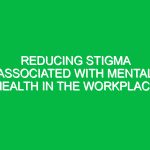Mental health is a crucial aspect of overall well-being, especially in high-stakes environments such as those governed by Health, Safety, and Environment (HSE) standards. In these domains, the need for effective resources and referrals for mental health assistance cannot be overstated. Addressing mental health concerns not only enhances individual productivity and satisfaction but also contributes to a safer workplace. This article will explore the intricacies of mental health resources and referrals, address potential hazards and risks associated with mental health in HSE contexts, and provide actionable best practices along with a review of relevant regulations.
Understanding Resources and Referrals for Mental Health Assistance
Resources and referrals for mental health assistance encompass a range of services and support systems designed to help individuals manage their mental health challenges. This can include access to counseling, therapy, support groups, and crisis intervention services. In the context of HSE, these resources are essential for addressing the psychological strains that can arise from workplace stressors, accidents, or traumatic events.
Imagine a construction site where the pressure of deadlines and safety regulations weighs heavily on workers. One incident—a near miss involving heavy machinery—can trigger anxiety or stress among employees. Having immediate access to mental health resources can help workers process their experiences and maintain a healthy work environment. Thus, integrating mental health resources into HSE protocols is not just beneficial; it’s vital.
Identifying Hazards and Risks Related to Mental Health in HSE
The HSE domain is fraught with various hazards that can adversely affect mental health. These can range from physical risks to psychological stressors. Here are some key hazards to consider:
1. Workplace Stress
Workplace stress can arise from excessive workloads, tight deadlines, and high expectations. Such stress can lead to burnout, anxiety, and depression. A study by the American Psychological Association found that roughly 61% of employees experience stress at work, which can significantly impact their mental well-being.
2. Traumatic Events
In sectors such as emergency response, construction, or manufacturing, workers may witness or be involved in traumatic incidents. This exposure can lead to post-traumatic stress disorder (PTSD) or acute stress reactions. The emotional toll of such experiences can linger long after the incident has passed.
3. Isolation
Workers in remote locations or those who work alone may feel isolated, which can exacerbate feelings of anxiety or depression. Lack of social support can make it challenging for individuals to seek help or express their feelings, leading to a cycle of worsening mental health.
4. Bullying and Harassment
Bullying, harassment, or discrimination in the workplace can have severe psychological effects. Victims often experience decreased self-esteem and increased anxiety, which can hinder their ability to perform their job safely and effectively.
5. Long Working Hours
Extended working hours can lead to fatigue and decreased mental clarity. The cumulative effects of sustained stress and reduced downtime can severely impact an employee’s mental health, leading to accidents and errors in judgment.
Safety Precautions and Best Practices for Mental Health in HSE
To mitigate the risks associated with mental health in the workplace, organizations must implement effective safety precautions and best practices. Here are some actionable strategies:
1. Promote a Culture of Open Communication
Encouraging employees to share their concerns and feelings fosters a supportive environment. Regular check-ins and feedback sessions can help identify issues before they escalate. For instance, a safety manager at a construction site implemented weekly mental health check-ins, which revealed that many workers felt overwhelmed by their workloads. Addressing this concern led to better distribution of tasks and reduced stress levels.
2. Provide Access to Mental Health Resources
Organizations should ensure that employees have access to counseling services, employee assistance programs (EAPs), and crisis hotlines. Making these resources readily available can empower employees to seek help when necessary. An example of this is a manufacturing company that partnered with a local mental health organization to offer on-site counseling services, significantly reducing absenteeism and improving morale.
3. Train Managers and Supervisors
Managers play a vital role in identifying mental health issues within their teams. Providing them with training on recognizing signs of stress or distress can help them support their employees effectively. For example, a utility company conducted training sessions for supervisors on mental health first aid, equipping them to assist employees in distress promptly.
4. Implement Flexible Work Arrangements
Flexibility in work hours or remote work options can reduce stress and improve work-life balance. This is particularly important in high-stress environments where employees may struggle to manage their personal and professional responsibilities. A logistics company that adopted flexible scheduling reported a marked improvement in employee satisfaction and retention rates.
5. Encourage Regular Breaks and Downtime
Encouraging employees to take regular breaks can help reduce stress and prevent burnout. Simple initiatives, like designated break times and relaxation areas, can create a more supportive work environment. For instance, an engineering firm introduced mandatory “mental health breaks,” allowing employees to step away from their tasks and recharge, which led to increased productivity and creativity.
Regulations and Standards Governing Mental Health Resources in HSE
Several regulations and standards govern the integration of mental health resources in the workplace. Understanding these legal frameworks is crucial for compliance and promoting a safe work environment. Here are some key regulations:
1. Occupational Safety and Health Administration (OSHA)
OSHA sets forth guidelines that require employers to provide a safe work environment, which includes addressing mental health risks. Employers are mandated to assess hazards and implement strategies to mitigate those risks, emphasizing the importance of mental well-being.
2. Americans with Disabilities Act (ADA)
The ADA prohibits discrimination against individuals with mental health conditions, ensuring they receive equal opportunities in the workplace. This law underscores the necessity for employers to provide reasonable accommodations for employees experiencing mental health challenges.
3. National Institute for Occupational Safety and Health (NIOSH)
NIOSH recommends incorporating mental health into workplace health programs. This includes promoting mental wellness and providing resources that support employees’ psychological well-being. Organizations are encouraged to develop comprehensive health programs that address both physical and mental health.
4. World Health Organization (WHO) Guidelines
The WHO offers guidelines on mental health in the workplace, emphasizing the need for preventive measures and early intervention. Their recommendations include creating mentally healthy work environments and implementing programs to support employee mental well-being.
Conclusion
Resources and referrals for mental health assistance are vital components of the Health, Safety, and Environment domain. By recognizing the hazards associated with mental health, implementing safety precautions, and adhering to regulations, organizations can foster a healthier and safer work environment. The importance of mental well-being cannot be overstated; it is the foundation upon which a productive and proactive workforce is built. In the end, investing in mental health resources is not just a regulatory obligation but a moral imperative that can lead to transformative changes in workplace culture and individual lives.


